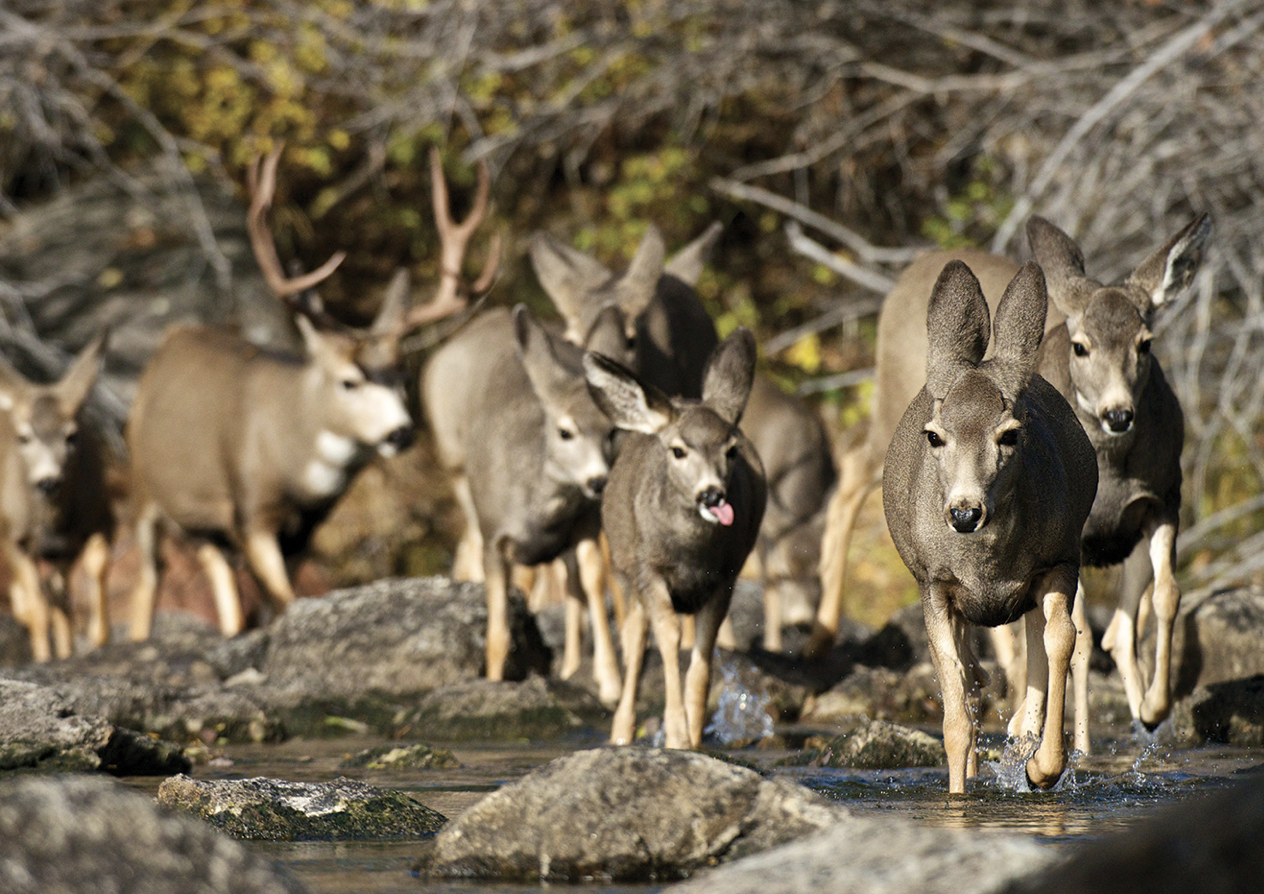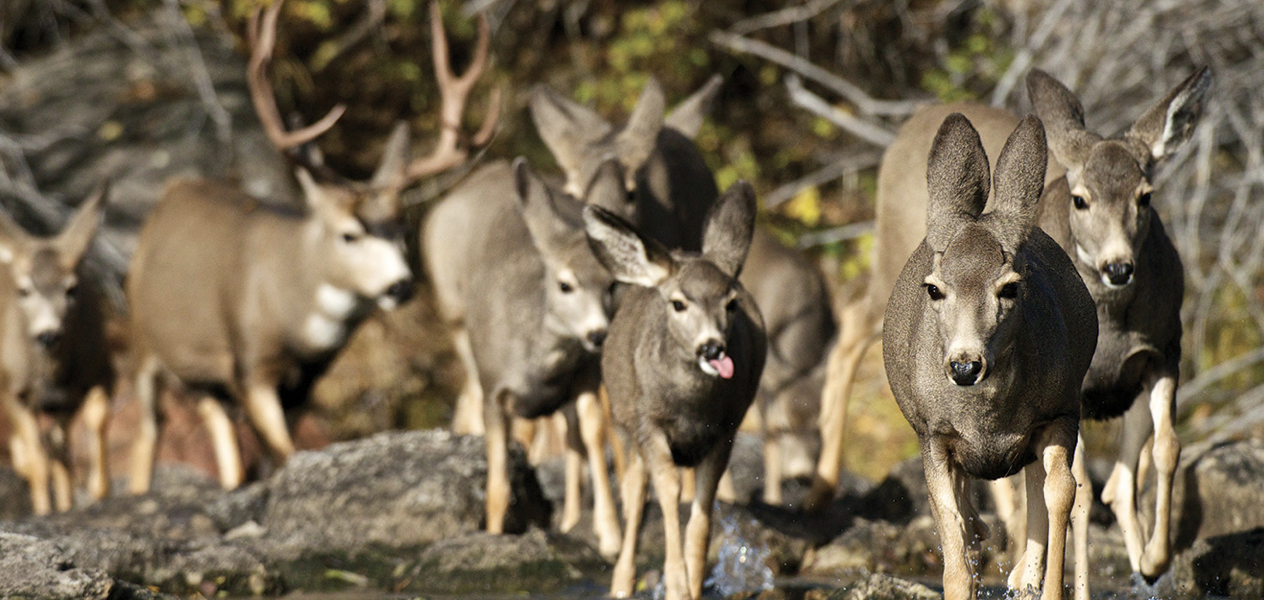
By Mike Koshmrl, WyoFile.com
PINEDALE—Sublette County Commission Chairman Joel Bousman questioned if it was necessary to delve into wildlife issues as the board mulled whether to OK a grocery store-sized medical facility on a parcel that harbors portions of the longest-known mule deer migration path in the world.
After all, he told the crowd in a Sublette County Library conference room, Wyoming’s migration policy “does not apply” to the private land where the development would occur.
When a neighboring resident, Kevin Roche, later questioned the commissioner’s remarks, Bousman, a lifelong rancher, recoiled. Bousman’s voice stiffened as he told Roche he’s been working with the Wyoming Game and Fish Department to help manage wildlife his “whole God damn life.
“Don’t accuse me about not caring for wildlife,” Bousman snapped back the afternoon of Oct. 4.
The tense exchange, one of several, preceded a vote in which Bousman and two fellow commissioners, Sam White and Tom Noble, voted to defy their unanimously opposed planning and zoning board and approve a conditional use permit allowing a 32,400-square-foot trauma therapy center for girls and young women to be built on land zoned agricultural just south of the Hoback Rim. The building footprint, an estimated 133 adjoining parking spaces and the accompanying human activity could soon be reality on the outskirts of a famous, protected corridor used by mule deer that migrate 150 miles from the Red Desert to the Hoback Basin.
It’s the third development encroaching on the migration path — Wyoming’s first designated corridor — that the three county commissioners have set in motion in the span of 10 months. A zoning change that’s now in litigation greenlighted an exclusive resort on deer-trodden ranchland owned by TD Ameritrade billionaire founder Joe Ricketts. Down Highway 189/191 toward Pinedale, the same trauma therapy center developer, Jason Moyes, convinced the Sublette County board to rezone 299 acres of former agricultural land that overlaps with the migration corridor to make way for a 51-lot subdivision.
The flurry of development highlights shortcomings in Wyoming’s policy, a Gov. Mark Gordon executive order that’s been held up as a national gold standard in the emerging field of migration conservation. Private landowners “should be encouraged and incentivized” to keep migrations functional, according to the order, but ultimately decisions fall to counties and the landowners themselves. So far in the Green River basin, the needle has leaned toward economic growth and providing housing for a community sorely lacking places to live. County officials have declined to outright preserve the open spaces that deer and pronghorn herds have thrived on for generations. Instead, developers like the Moyes family are weighing whether to make voluntary concessions for the ungulates.
Meantime, the slow pace of getting corridors designated and protections in place is also on display in Sublette County. The 51-lot subdivision likely also intersects with the Sublette Pronghorn Migration, also known as the Path of the Pronghorn, used by animals that famously migrate all the way to Jackson Hole. The route has been known by researchers for nearly two decades, but political pressure has stymied the protection of southern segments, both on the federal level and via Wyoming’s migration designation process.
Decisions favoring development on open agricultural lands that harbor “national treasure” migrations have left wildlife advocates like Muley Fanatic Foundation co-founder Josh Coursey “frustrated.” The risks and consequences are “immeasurable,” he said.
“When you have overwhelming support one way or another, and then [the decision] goes against the grain of the voice of the people — which this has — it just leaves you in defeat,” Coursey said. “You just shake your head in disgust.”
The migration policy’s lack of teeth on private land has put wildlife managers who oversee the Sublette Mule Deer Herd in an awkward position. Brandon Scurlock, the agency’s Pinedale Region wildlife coordinator, said he’s been pressured by development opponents to come in and “stop it,” but that no such authority exists. In commission and planning and zoning meetings this fall, he presented information about the various types of wildlife habitat on both tracts of land where the Moyes family seeks to build. But even that level of involvement has been scrutinized.
“Game and Fish has got into the middle of it, and their statements, I felt, kind of went against what the [migration] regulation states,” Sublette County Planner Dennis Fornstrom said. “Their whole discussion was how important this wildlife corridor was, how it couldn’t be disturbed, stuff like that.”
In an interview, Scurlock explained that it’s not just deer migration he’s concerned about. The 51-lot subdivision, he said, overlaps with core sage grouse habitat and contains both low-use and medium-use designated migration corridors, as well as a mule deer “stopover” habitat on the property where houses aren’t planned up on a hillside. A second attempt to get the pronghorn migration path designated awaits, but the GPS collar data already amassed suggests the coming subdivision “probably” would be in their path, he said.
“There’s migrating pronghorn that go through there, but it’s also spring, summer and fall range for pronghorn,” Scurlock said. “Our biggest concern is that there’s already a pretty substantial subdivision to the east of the highway, and that’s forcing a lot of the pronghorn to the west side of the highway where there is no development.”
Now that’s likely to be built on, too.
The Moyes property at the Hoback Rim — where the therapy center was approved — is equally wildlife rich. Every acre of that land, according to Scurlock, is classified as crucial moose range, both winter and year-long. Low-use portions of the Red Desert-to-Hoback migration cover “most” of the property, he said, and medium-use corridor treads over the southern half of the property. Again, there’s no officially designated pronghorn migration path, but biologists know that pronghorn move through the area.
“There’s an open grassy pasture on the east side of this property adjacent to the highway,” Scurlock said. “They use that, as well as the other side of the highway, to get down into Bondurant for summer range and also to get out of Bondurant during the fall.”
According to Scurlock, there have also been reports that the property could be classified as crucial elk winter range, too. The Roosevelt Fire altered that species’ distribution by making unburned forest on the property more valuable, he said.
A few years ago John Carter moved to the Hoback Ranches subdivision just up the road from the proposed therapy center to wind down a career as an environmental engineer.
Carter, who has a track record of environmental activism— he founded a nature preserve — said the therapy center’s public appeal makes it tough to fight. “It’s like mother, God and apple pie,” Carter said. “Nobody will oppose it.”
Even some neighbors who aren’t keen on the therapy center see it better than the alternative: the Moyes family could break up their 614 acres into ranchettes on 35-acre parcels.
“A hippy hospital sounds a lot better than 8,000-square-foot mega mansions and third homes for the Jackson folks,” neighbor Tracy Tominc told commissioners at the Oct. 4 meeting.
Still, Tominc was unhappy about the change afoot in his neighborhood.
“I’m not down with lawyers and I’m not down with California real estate investors,” he said. “Nobody’s ever come and said, ‘Hi, I’m your new neighbor.’ Nobody’s ever come and said, ‘Hey, I’m thinking about doing this, what do you think about it?’”
Jason and Melinda Moyes, a real estate agent, left San Joaquin Valley in central California and came to Sublette County after searching for a place where they could raise their kids and see through their vision for the therapy center, dubbed The Sanctuary.
“I think we were here for about eight hours before our whole family knew this was the place,” Jason Moyes told WyoFile.
The natural beauty, nearby national parks and Wind River Range were all a draw, he said. So were the locals, who the family found “unbelievably friendly” and welcoming, he said. The wildlife, too, was part of the allure.
“I think that’s a neat element to see,” Moyes said. “And certainly, it’s an element we don’t want to damage or destroy in any way.”
Moyes also has local backing as he’s moved toward developing the two controversial parcels plus a third within the town of Pinedale. The developments on the drawing board would add housing to a community that desperately needs it, High Mountain Real Estate owner and broker Chase Harber said. The housing market, like in much of Wyoming, is “extremely tight,” he said.
“When I look for something for first-time homebuyer types, it’s hard to find something for under $500,000,” Harber said. “With interest rates climbing, that’s a $4,000 [monthly] mortgage. There’s not a lot of people that can afford that.”
Harber predicted homes in the 51-lot subdivision will be in the $500,000 to $600,000 range. The lots are large enough that they’ll likely accommodate horses, and properties on acreage with those attributes are in high demand. The development, he said, would be attractive to people who live in Pinedale and want to size up, and in the process it could free up entry-level housing in town.
Moyes is also planning a more affordable subdivision, which he calls the Bloomfield Project, near Pinedale Elementary School. “What we’re looking at is more of a first-time homebuyer option to create some housing stock that’s desperately needed,” he said.
The family is eyeing 60 units total, including some multi-family homes, on 16 acres.
Although the large majority of people who have spoken up about the therapy center have contested the facility, that project has its proponents, too. Melinda Bobo, a rector at Pinedale’s St. Andrew’s in the Pines Episcopal Church, advocated for the Moyes’ Hoback Rim plan at the county meeting.
“This is not a hospital, this is not a retreat center — this is a sanctuary,” Bobo said. “The definition of what it’s about necessitates it being in wild space.”
Young women who have been traumatized, abused, threatened and beaten would be there to “try to get their lives back,” she said.
Commissioner Bousman agreed that the therapy center would be a benefit to Sublette County.
“I’m not worried about the wildlife,” Bousman said. “I’d be far more worried if there was a house on every 35 acres and how that might disrupt wildlife migration.”
Although Wyoming’s migration policy doesn’t have the force of law on the Moyes family’s private land, Renny MacKay, the governor’s policy director, said “we hope and believe” consultation with Game and Fish will guide the development.
“The private landowner is looking at it and trying to create space,” MacKay said. “There have been discussions and consultations.”
Migration science, according to MacKay, doesn’t show that preservation is always necessary to keep a corridor functional.
“There are development thresholds,” he said. “As we look at the components and the risks and the threats [to a migration corridor], it may necessitate different approaches in different places.”
Scurlock and Moyes have visited the sites together and are in talks.
At the Rim parcel, Moyes is planning to put the building in the northwest corner of the parcel outside of the Red Desert-to-Hoback deer migration path.
“He’s trying to at least show that it’ll have as little impact as possible,” Scurlock said.
When a disconnected buck-and-rail fence went up on the south side of the property, wildlife managers asked for some voluntary modifications so pronghorn could scoot underneath. Moyes said he’d remove every other bottom rail if the fence ever gets fully enclosed.
There are talks of an ungulate bypass path through the subdivision, too.
“I know it’s not going to be popular with him to have a 250 or 300-meter-wide buffer,” Scurlock said, “but I’m trying to sell it like, maybe he could charge more for those lots because you’re right next to the Red Desert-to-Hoback migration. They’re right in your backyard.”
Moyes is considering it. Blocking out building pads on lots through deed restrictions and adding conditions that mandate wildlife fencing are both possibilities, he said.
There are more resources available than ever before for making accommodations for wildlife migration through private land. In May, the U.S. Department of Agriculture committed $15 million for a Wyoming pilot project that incentivizes willing landowners to conserve private lands for the benefit of migratory big game. A migration researcher with Wyoming ties, Arthur Middleton, has also been named a senior advisor to that federal executive department (Disclosure: Middleton is married to WyoFile board of directors member Anna Sale.)
Early this year, Middleton authored a Wyoming Law Review article that breaks down the role of private land in conserving the Greater Yellowstone Ecosystem’s wildlife in the 21st Century. He recently spoke to the topic in an online Montana Institute on Ecosystems forum, during which the Sublette County migrations and the pending developments came up. There’s an “enormous” amount of implementation work ahead, he said, and a sense of urgency to protect private land swaths of ecological marvels like the Red Desert-to-Hoback migration.
“I do feel like it’s a race, and I feel a lot of stress about that and a lot of pressure,” Middleton said. “We have to do a lot of quick work to build up that delivery system.”
Meantime, Sublette County wildlife advocates are lamenting what they see as a series of defeats. Bondurant resident Dan Bailey said the commissioners’ approval of the therapy center, in defiance of their planning and zoning board’s recommendation, was a “tragedy.”
“It’s blind to think our development is not going to have a huge impact,” Bailey said. “We’re going to lose what’s special about Wyoming unless we wake up.”





